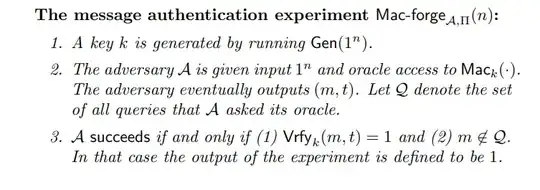I'm looking at the MAC defined as follows: $$\text{Mac}_k(m)=\langle r,f_k(r\oplus m)\rangle $$ where $r$ is uniformly chosen at random (each time) and $f_k$ is a PRF. Vrfy is the canonical one. I'm trying to refute that it is secure (secure definition below).
The Mac-Forge game is defined here:

Now, the forgery will work as follows: the attacker picks two messages $m_1,m_2$ with $m_1\neq m_2$. He then calls the oracle with both messages (separately) and gets back $(m_1,t_1),(m_2,t_2)$. Then, he returns: $$(r_1\oplus r_2\oplus m_1, \langle r_2, t_1\rangle) $$ This tag is valid unless $r_1\oplus r_2\oplus m_1$ equals $m_1$ or $m_2$. The first case happens when $r_1\oplus r_2=0^n$ which happens with probability $1/2^n$. The second case happens with probability $1/2^n$ for the same reason. Using the union bound: $$\Pr[r_1\oplus r_2 = 0^n \vee r_1\oplus r_2 = m_1\oplus m_2]\le \frac{2}{2^n}=\frac{1}{2^{n-1}}$$ So: $$\Pr[\text{Mac-forge}_{\mathcal{A},\pi}(n)=1]> 1-\frac{1}{2^{n-1}}$$ which is not negligible.
